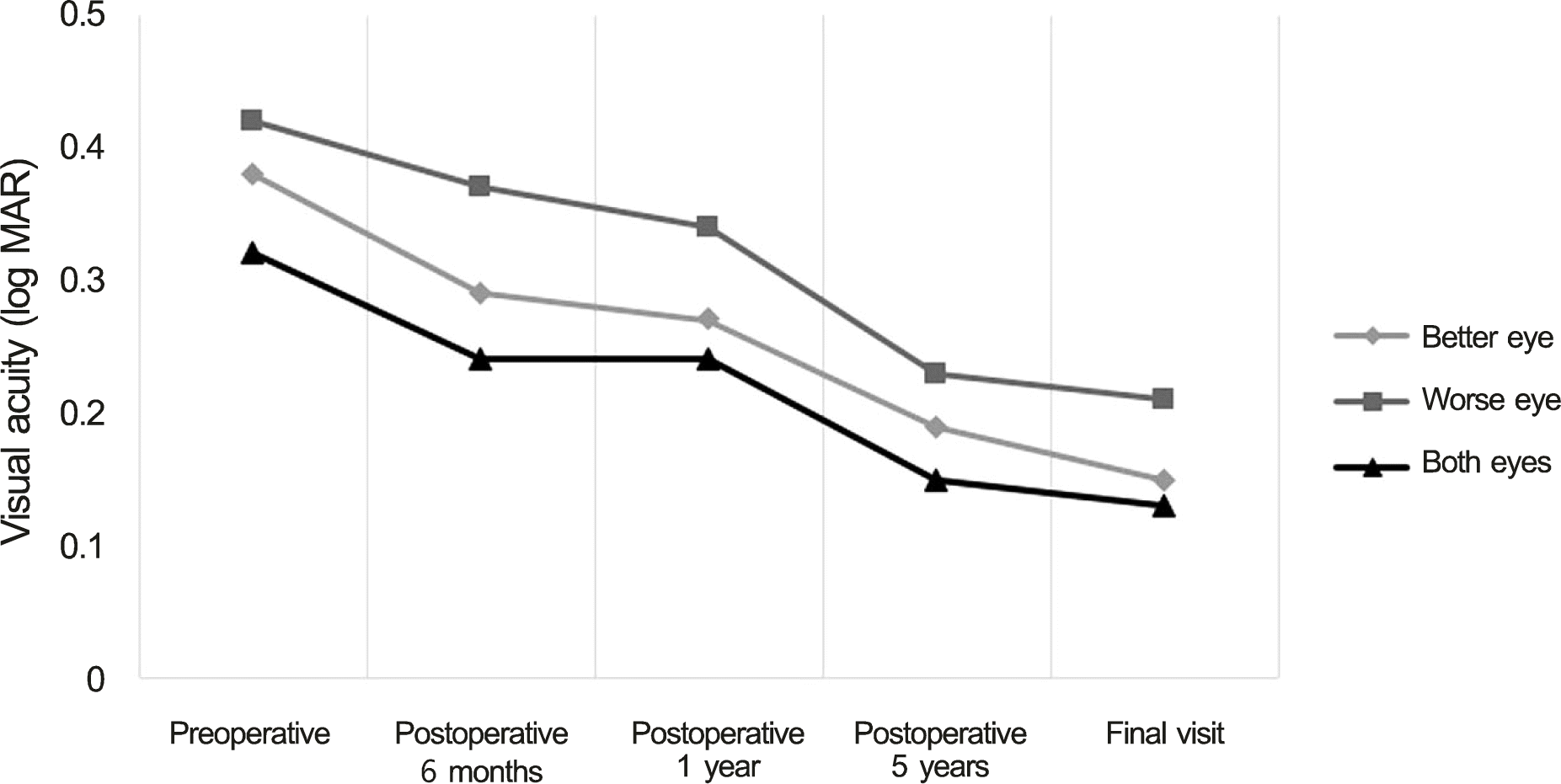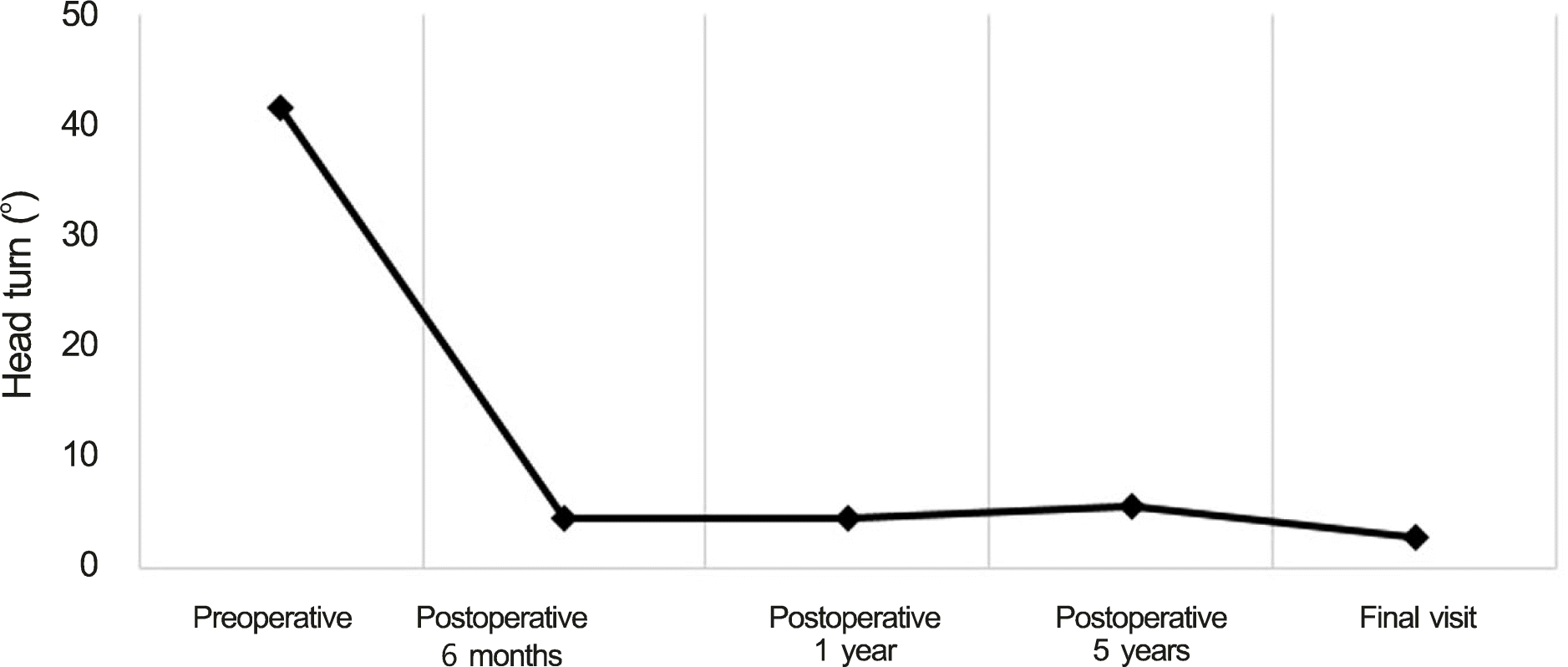Abstract
Purpose
To evaluate the long-term outcome and recurrence of abnormal head posture after modified Kestenbaum surgery in patients with nystagmus.
Methods
The medical records of 46 patients who underwent modified Kestenbaum procedure in horizontal recti muscles for nystagmus with abnormal head turn were retrospectively reviewed. We assessed the effect of surgery by comparing pre-operative and postoperative clinical data such as visual acuity (log MAR) and degree of head turn. A reoperation or abnormal head turn of 10° or more at final visit were defined as recurrence. Patients were divided into 2 groups according to the presence of recurrence or reoperation. Clinical factors associated with recurrence or reoperation were compared between the 2 groups.
Results
The mean visual acuity was 0.38 in the better eye and 0.42 in the worse eye before surgery, which improved to 0.15 and 0.21 after surgery (each p < 0.001), with a mean follow-up period of 124 months. The mean degree of head turn was 41.41° pre-operatively and was changed to 2.61° postoperatively (p < 0.001). The recurrence rate was 23.9% and the reoperation rate was 10.9%. Mental retardation, amblyopia, preoperative visual acuity, degree of head turn, and presence of strabismus were not as-sociated with recurrence or reoperation. The mean age at first surgery was significantly lower in the reoperation group (p = 0.009). The mean visual acuity in the better eye at postoperative 6 months and in better and worse eyes at postoperative 1 year was significantly worse in the reoperation group (p = 0.034, 0.012 and 0.009, respectively).
Conclusions
The visual acuity and head turn was improved after modified Kestenbaum surgery in patients with nystagmus and abnormal head posture. The reoperation rates were associated with earlier age of first operation and worse postoperative visual acuity. However, further prospective studies are necessary to clarify these factors.
References
1. Park HJ, Chang BL. Congenital nystagmus. J Korean Ophthalmol Soc. 1990; 31:343–50.
2. KSPOS. Current Concepts in Strabismus. 3rd ed.Goyang, Gyeonggido: Naewae Haksool;2013. p. 394–411.
3. Bae JH, Song JK. Surgical treatment of congenital nystagmus. J Korean Ophthalmol Soc. 1987; 28:811–6.
4. Lee JB, Lee IS, Kim HS, Han SH. The effect of modified kestenbum procedure (6-7-6-7mm) for abonormal heal position in in-fantile nystagmus. J Korean Ophthalmol Soc. 1997; 38:2207–13.
5. Kestenbaum A. [New operation for nystagmus]. Bull Soc Ophtalmol Fr. 1953; 6:599–602.
6. Anderson JR. Causes and treatment of congenital eccentric nystagmus. Br J Ophthalmol. 1953; 37:267–81.

7. Parks MM. Symposium: nystagmus. Congenital nystagmus surgery. Am Orthopt J. 1973; 23:35–9.
8. Calhoun JH, Harley RD. Surgery for abnormal head position in congenital nystagmus. Trans Am Ophthalmol Soc. 1973; 71:70–83. discussion 84-7.
9. Nelson LB, Ervin-Mulvey LD, Calhoun JH. . Surgical man-agement for abnormal head position in nystagmus: the augmented modified Kestenbaum procedure. Br J Ophthalmol. 1984; 68:796–800.

10. Mitchell PR, Wheeler MB, Parks MM. Kestenbaum surgical procedure for torticollis secondary to congenital nystagmus. J Pediatr Ophthalmol Strabismus. 1987; 24:87–93.
11. Taylor JN. Surgery for horizontal nystagmus-Anderson-Kestenbaum operation. Aust J Ophthalmol. 1973; 1:114–6.

12. Lee IS, Lee JB, Kim HS. . Modified Kestenbaum surgery for correction of abnormal head posture in infantile nystagmus: outcome in 63 patients with graded augmentaton. Binocul Vis Strabismus Q. 2000; 15:53–8.
13. Cho YA, Chung HR. Surgical treatment of asymmetric gaze nystagmus. J Korean Ophthalmol Soc. 1986; 27:191–8.
14. Chang YH, Chang JH, Han SH, Lee JB. Outcome study of two standard and graduated augmented modified Kestenbaum surgery protocols for abnormal head postures in infantile nystagmus. Binocul Vis Strabismus Q. 2007; 22:235–41.
15. Dell'Osso LF, Flynn JT. Congenital nystagmus surgery. A quantitative evaluation of the effects. Arch Ophthalmol. 1979; 97:462–9.
Figure 1.
Change in the visual acuity after the modified Kestenbaum surgery in the patients with nystagmus and abnor-mal head turn.

Figure 2.
Change in the degree of head turn after the modified Kestenbaum surgery in the patients with nystagmus and abnormal head turn.

Table 1.
Mean amount of resection and recession of horizontal muscles according to the degree of left head turn in various modified Kestenbaum procedures
| Head turn (°) | RLR recession (mm) | RMR resection (mm) | LMR recession (mm) | LLR resection (mm) |
|---|---|---|---|---|
| 20 | 6.0 | 5.0 | 4.0 | 7.5 |
| 25-30 | 7.5 | 5.5 | 5.6 | 7.5 |
| 35-50 | 8.5 | 6.6 | 6.4 | 8.8 |
| 55-60 | 9.3 | 7.3 | 7.0 | 9.8 |
Table 2.
Preoperative types of strabismus and head posture in individual patients
Table 3.
Change in the visual acuity after the modified Kestenbaum surgery in the patients with nystagmus and abnormal head turn
| Eye | Preoperative VA (log MAR) |
Postoperative VA (log MAR) |
|||||||
|---|---|---|---|---|---|---|---|---|---|
| 6 months | p-value∗ | 1 year | p-value∗ | 5 years | p-value∗ | Final visit | p-value∗ | ||
| Better eye | 0.38 | 0.29 | <0.001 | 0.27 | <0.001 | 0.19 | <0.001 | 0.15 | <0.001 |
| Worse eye | 0.42 | 0.37 | 0.003 | 0.34 | 0.002 | 0.23 | 0.001 | 0.21 | <0.001 |
| Both eyes | 0.32 | 0.24 | <0.001 | 0.24 | <0.001 | 0.15 | <0.001 | 0.13 | <0.001 |
Table 4.
Change in the degree of head turn after the modified Kestenbaum surgery in the patients with nystagmus and abnormal head turn
| Preoperative |
Postoperative **** |
||||||||
|---|---|---|---|---|---|---|---|---|---|
| 6 months | p-value∗ | 1 year | p-value∗ | 5 years | p-value∗ | Final visit | p-value∗ | ||
| Head turn (°) | 41.41 | 4.34 | <0.001 | 4.51 | <0.001 | 5.44 | <0.001 | 2.61 | <0.001 |
Table 5.
Comparison of clinical characteristics between groups with and without the recurrence of head turn after the modified Kestenbaum surgery in the patients with nystagmus and abnormal head turn
| Recurrence group | Success group | p-value | |
|---|---|---|---|
| Number of patients (%) | 11 of 46 (23.9) | 34 of 46 (73.9) | |
| Presence of strabismus (%)† | 0 (0) | 4 (11.8) | 0.558 |
| Presence of amblyopia (%) | 8 (72.7) | 25 (78.1) | 1.000 |
| Presence of mental retardation (%) | 0 (0) | 2 (5.9) | 1.000 |
| Age at the first surgery (years)∗ | 5.9 ± 2.86 | 7.9 ± 4.14 | 0.174 |
| Preop. head turn (°)∗ | 42.27 ± 6.47 | 41.47 ± 11.11 | 0.893 |
| Preop. VA (log MAR)∗ | |||
| Better eye | 0.40 ± 0.31 | 0.38 ± 0.28 | 0.874 |
| Worse eye | 0.41 ± 0.29 | 0.42 ± 0.30 | 0.858 |
| Both eyes | 0.35 ± 0.28 | 0.31 ± 0.26 | 0.728 |
| Postop. 6 momths head turn (°)∗ | 7.60 ± 13.50 | 3.33 ± 4.36 | 0.361 |
| Postop. 6 months VA (log MAR)∗ | |||
| Better eye | 0.36 ± 0.24 | 0.25 ± 0.22 | 0.219 |
| Worse eye | 0.39 ± 0.25 | 0.34 ± 0.26 | 0.552 |
| Both eyes | 0.31 ± 0.26 | 0.21 ± 0.21 | 0.375 |
| Postop. 1 year head turn (°)∗ | 9.50 ± 14.18 | 3.00 ± 4.01 | 0.192 |
| Postop. 1 year VA (log MAR)∗ | |||
| Better eye | 0.33 ± 0.20 | 0.23 ± 0.22 | 0.111 |
| Worse eye | 0.44 ± 0.30 | 0.29 ± 0.24 | 0.115 |
| Both eyes | 0.27 ± 0.20 | 0.22 ± 0.24 | 0.341 |
| Final head turn (°)∗ | 7.73 ± 8.77 | 1.03 ± 1.87 | 0.012 |
| Final VA (log MAR)∗ | |||
| Better eye | 0.14 ± 0.15 | 0.15 ± 0.22 | 0.562 |
| Worse eye | 0.24 ± 0.23 | 0.20 ± 0.23 | 0.503 |
| Both eyes | 0.11 ± 0.16 | 0.13 ± 0.21 | 0.902 |
Table 6.
Comparison of clinical characteristics between groups with and without reoperation after the modified Kestenbaum surgery in the patients with nystagmus and abnormal head turn
| Reoperation group | Non-reoperation group | p-value | |
|---|---|---|---|
| Number of patients (%) | 5 of 46 (10.9) | 40 of 46 (87.0) | |
| Presence of strabismus (%)† | 0 (0) | 4 (10.0) | 1.000 |
| Presence of amblyopia (%) | 2 (40.0) | 31 (77.5) | 0.109 |
| Presence of mental retardation (%) | 0 (0) | 2 (5) | 1.000 |
| Age at the first surgery (years)∗ | 4.0 ± 1.55 | 7.8 ± 3.93 | 0.009 |
| Preop. head turn (°)∗ | 42.00 ± 6.71 | 41.63 ± 10.52 | 1.000 |
| Preop. VA (log MAR)∗ | |||
| Better eye | 0.47 ± 0.21 | 0.37 ± 0.29 | 0.378 |
| Worse eye | 0.47 ± 0.21 | 0.41 ± 0.30 | 0.554 |
| Both eyes | 0.47 ± 0.21 | 0.31 ± 0.27 | 0.182 |
| Postop. 6 months head turn (°)∗ | 15.00 ± 20.41 | 3.23 ± 4.09 | 0.121 |
| Postop. 6 months VA (log MAR)∗ | |||
| Better eye | 0.54 ± 0.15 | 0.25 ± 0.22 | 0.034 |
| Worse eye | 0.54 ± 0.15 | 0.34 ± 0.26 | 0.106 |
| Both eyes | 0.46 ± 0.28 | 0.21 ± 0.21 | 0.097 |
| Postop. 1 year head turn (°)∗ | 17.50 ± 20.21 | 3.18 ± 4.23 | 0.090 |
| Postop. 1 year VA (log MAR)∗ | |||
| Better eye | 0.49 ± 0.06 | 0.23 ± 0.21 | 0.012 |
| Worse eye | 0.69 ± 0.23 | 0.28 ± 0.24 | 0.008 |
| Both eyes | 0.44 ± 0.11 | 0.21 ± 0.23 | 0.028 |
| Final head turn (°)∗ | 0.00 ± 0.00 | 3.00 ± 5.58 | 0.106 |
| Final VA (log MAR)∗ | |||
| Better eye | 0.17 ± 0.22 | 0.14 ± 0.20 | 0.940 |
| Worse eye | 0.31 ± 0.33 | 0.20 ± 0.21 | 0.551 |
| Both eyes | 0.15 ± 0.23 | 0.13 ± 0.20 | 0.751 |




 PDF
PDF ePub
ePub Citation
Citation Print
Print


 XML Download
XML Download